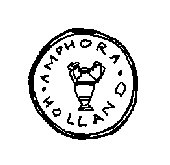|
Groninger Steenfabrieken N.V. / Adco (1904-1977) |
| ADCO |
|
|
|
|
|
Tegel en Fayencefabriek Amphora (1908-1933)
Influenced by Rozenburg. The work of this factory is
easily confused with the Bohemian factory as the two factories produced their
earthenware in the same era, and (roughly) in the same style. Participating
artists were, among others, C.J.
van der Hoef (see list of potters / ceramic artists). |
AMPHORA
HOLLAND |
 |
|
|
|
|
Fayencefabriek Amstelhoek (1900 - 1910)
Founded by Willem Hoeker (who would later on co-found 't
Binnenhuis) to produce earthenware. Earthenware of Amstelhoek was designed by, among
others, C.J.
van der Hoef and L.
Zijl. Later on the earthenware factory was enlarged with a metal workshop (artistic
director: Jan Eisenloeffel) and a furniture making workshop (artistic
director: Willem Penaat). Amstelhoek followed the sober Dutch 'nieuwe kunst'
(see the bottom of this page)
-design school: making geometrically formed and decorated products. Amstelhoek
is a good example of different disciplines working together in one enterprise,
making artistically thought through items. In 1903 Amstelhoek went bankrupt, but the company was taken over by two former
employees, who continued the factory by the name " Fabriek van gebruiks- en
sieraardewerk enz. V.H. Amstelhoek ". They added the letters V.H. to
the existing mark (V.H. stands for 'voor heen', which means: 'formerly'). In
1907 the earthenware models (plus reproduction rights) of Haga
were incorporated in the factory. In 1910 the company was taken over by De
Distel. |
 |

AMSTERDAM
.HOLLAND. |
|
|
|
|
N.V.Arnhemsche Fayencefabriek
(1907-1946)
The Arnhemsche Fayencefabriek was founded by the founders of Plateelfabriek
Purmerend, Jacob Vet and Klaas Vet. They continued to produce earthenware at
Arnhem in the same style as they produced before, at Plateelfabriek Purmerend. |
 |
 |
ARNHEM
HOLLAND |
RHODUS
K. & Co.
A ' D A M
Holland |
AF |
|
Firma Weduwe N.S.A. Brantjes en Co.
(1895-1904)
The designs of the pottery were inspired, among others, by the Rozenburg factory. The symbol used as a mark by the Brantjes pottery is that of a
wooden shoe. In 1904 the Brantjes company joined the N.V. Terracottafabriek Haga
(also known as Beeldenfabriek H.F. Antheunis) to form together Haga.
Among the decorators were C.J.
Lanooy and Jacob Vet. |

NB
Faience de
Purmerende
Holland |

NB
Delftsch |

NB
Holland |
|
|
|
Plateelbakkerij De Distel (1895-1923)
Participating artists at De Distel were, among others, L. Nienhuis, J.
Eisenloeffel, W.H.
van Norden, C.A.
Lion Cachet, Th. Nieuwenhuis, Matthieu Wiegman and Jac.
van den Bosch. In 1910 V.H. Amstelhoek was incorporated in De Distel,
and in 1923 De Distel was incorporated into Goedewaagen. |
| DISTEL |
 |
 |
|
|
|
Dordtsche Kunstpotterij / D.K.P. (1903-1908)
Decorations in the style of Christiaan
van der Hoef and Rozenburg. |
DORDTSCHE
KUNSTPOTTERIJ
HOLLAND |
D.K.P.
DORDRECHT
HOLLAND |
|
|
|
|
De Duinvoet (1923-1927)
Designs of Van Muyen and Cor Alons (also see De
Vier Paddenstoelen). |
| DUINVOET |
DUINVOET

HAAG |
|
|
|
|
Eerste Steenwijkse Kunst Aardewerk Fabriek / ESKAF
(1919-1927)
The factory was based from 1919 - 1927 in Steenwijk. In 1927 it was liquidated,
but 'revived' (by new owners) in Huizen. There the factory continued to produce
earthenware until 1934. Participating artist at ESKAF Steenwijk was, among
others, Hildo
Krop. |
 |
ESKAF |
 |
ESKAF
HOLLAND |
HUIZEN
HOLLAND |
|
Keramische Industrie Fris N.V. (1943-1969) |
 |
STUDIO
FRIS
MADE IN HOLLAND |
|
|
|
|
Plateelfabriek Gelria N.V. (1926-1932) |
GELRIA
ARNHEM
HOLLAND |
ARNHEM
HOLLAND |
|
|
|
|
Koninklijke Hollandsche Pijpen- en Aardewerkfabriek N.V. Goedewaagen
/ Goedewaagen's Koninklijke Hollandsche Pijpen- en Aardewerkfabriek N.V. / Royal
Goedewaagen (1779-) Originally a factory making clay pipes. When, in the beginning 20th
century, the
public interest in pipes diminished, Goedewaagen changed to manufacturing
pottery. In 1923 De Distel was incorporated by Goedewaagen. Occasional participating artists at Goedewaagen
were, among others,
J. Gidding, L. Nienhuis, the sculptress Gra
Rueb and the artist Theo Vos. |
ROYAL
GOEDEWAAGEN GOUDA
MADE IN HOLLAND |
 |
|
|
|
|
Plateelbakkerij Haga (1904-1907)
Participating artists at Haga were, among others, C.J.
van der Hoef and C.J. Lanooy.
Haga was the result of the joining of the firm of Brantjes
with N.V. Terracotta- en Aardewerkfabriek Haga (also known as Beeldenfabriek H.F.
Antheunis) in 1904. In 1907 the earthenware models (plus the reproduction
rights)
of Haga were incorporated in V.H. Amstelhoek. In 1910 V.H. Amstelhoek was taken over by De Distel and in 1923
De Distel was incorporated into Goedewaagen. |

HAGA |
HAGA |
|
|
|
|
Fayence- en Tegelfabriek Holland
(1893-1920)
Participating artists were, among others, Jac.
van den Bosch, H.P.
Berlage and J.W. Mijnlief. |
HOLLAND
UTRECHT |
|
|
|
|
|
Plateelfabriek fa. P. van der Want Gzn. / Ivora
(1630-1965)
The factory started in 1630 with the production of clay pipes. Descendants of
this family started Regina and Zenith.
Participating artist were, among others, J.
Schonk. |
Fa.
P. v.d. Want Gz.
Gouda |
IVORA
GOUDA
HOLLAND |
|
|
|
|
Aardewerkfabriek De Kat (1902-1918)
The designs and decorations were inspired by the work of C.J.
van der Hoef and W.C.
Brouwer. |
 |
|
|
|
|













